Wednesday, November 02, 2005
The Plane in Rain
 The recent rains which flooded parts of New England also provided several days of good IFR conditions. One particularly wet day saw us up for some local approaches. It was the first truly lousy day that we'd been up. Rain, heavy at times, and gusty winds were accurately forecast all day. The winds aloft at 3,000 ft were forecast to be in the vicinity of 50 knots, so it was going to be a rough ride.
We departed under a ragged ceiling and were in the clouds by 2,000 ft. There was rougher weather to the west of the field, and we were catching rain and plenty of turbulence at its edges at 3,000 ft as ATC vectored us north for the VOR 20 approach.
The recent rains which flooded parts of New England also provided several days of good IFR conditions. One particularly wet day saw us up for some local approaches. It was the first truly lousy day that we'd been up. Rain, heavy at times, and gusty winds were accurately forecast all day. The winds aloft at 3,000 ft were forecast to be in the vicinity of 50 knots, so it was going to be a rough ride.
We departed under a ragged ceiling and were in the clouds by 2,000 ft. There was rougher weather to the west of the field, and we were catching rain and plenty of turbulence at its edges at 3,000 ft as ATC vectored us north for the VOR 20 approach.
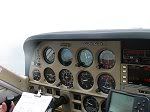 As we descended on the final approach segment, things improved somewhat, but it was still a bumpy ride down to MDA. Visibility was generally less than three miles due to the ragged ceiling and rain, and the gusty headwinds kept our groundspeed below the 90 knots normally flown. Our usual 800 feet/minute descent used for non-precision approaches would have put us at MDA with a few miles still to go before reaching the missed approach point, so we shallowed our descent rate so as to bring us to MDA closer to the airport. This had the added advantage, for practice purposes, of keeping us in the clouds longer.
As we descended on the final approach segment, things improved somewhat, but it was still a bumpy ride down to MDA. Visibility was generally less than three miles due to the ragged ceiling and rain, and the gusty headwinds kept our groundspeed below the 90 knots normally flown. Our usual 800 feet/minute descent used for non-precision approaches would have put us at MDA with a few miles still to go before reaching the missed approach point, so we shallowed our descent rate so as to bring us to MDA closer to the airport. This had the added advantage, for practice purposes, of keeping us in the clouds longer.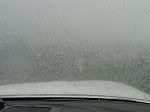 We broke out somewhere between 2,000 feet and 1,000 feet, but the fuzzy ceiling and low visibility hid the airport until the approach lights emerged faintly from the mist. They had been OTS for a while due to construction work on the end of the runway, but they were in fine form and greatly appreciated this day. We continued tracking inbound until reaching the MAP at the VOR transmitter, then went missed, back up into the overcast, and requested vectors for the ILS 20.
This was the first time I'd been up in real rain, and it brought a few new experiences. In addition to the low visibility, there was also the added distraction of the audible sound of raindrops hitting the windshield and airframe, and incessant precipitation static on the NAV frequencies made identifying the various navaids a little more challenging. Cessnas have a reputation for leaking in the rain, but I was happy to see that we didn't get much water in the cabin. That was about to change.
We broke out somewhere between 2,000 feet and 1,000 feet, but the fuzzy ceiling and low visibility hid the airport until the approach lights emerged faintly from the mist. They had been OTS for a while due to construction work on the end of the runway, but they were in fine form and greatly appreciated this day. We continued tracking inbound until reaching the MAP at the VOR transmitter, then went missed, back up into the overcast, and requested vectors for the ILS 20.
This was the first time I'd been up in real rain, and it brought a few new experiences. In addition to the low visibility, there was also the added distraction of the audible sound of raindrops hitting the windshield and airframe, and incessant precipitation static on the NAV frequencies made identifying the various navaids a little more challenging. Cessnas have a reputation for leaking in the rain, but I was happy to see that we didn't get much water in the cabin. That was about to change.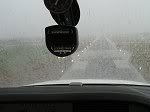 We were being vectored outbound for the LOC 20 and were bouncing around pretty steadily in the turbulence when I felt a sudden blast of cold wet air on my left side. For a few microseconds, I reviewed what I knew of the Cardinal ventilation system, and remembering that there were no fresh air vents on that side of the cabin, I concluded that my door had come open. During my PPL training, Faithful Instructor George would occasionally reach around behind my back and pop open the window on the Skyhawk for a realistic distraction while on short final or other opportune moments, but Cardinal windows don't open, and I'd never experienced anything similar with Yellowbird before. I gave the plane to George and tried to close the door, but it takes a good solid pull to get it closed enough for the bolt to catch, and I couldn't get it open far enough to slam it shut.
We were being vectored outbound for the LOC 20 and were bouncing around pretty steadily in the turbulence when I felt a sudden blast of cold wet air on my left side. For a few microseconds, I reviewed what I knew of the Cardinal ventilation system, and remembering that there were no fresh air vents on that side of the cabin, I concluded that my door had come open. During my PPL training, Faithful Instructor George would occasionally reach around behind my back and pop open the window on the Skyhawk for a realistic distraction while on short final or other opportune moments, but Cardinal windows don't open, and I'd never experienced anything similar with Yellowbird before. I gave the plane to George and tried to close the door, but it takes a good solid pull to get it closed enough for the bolt to catch, and I couldn't get it open far enough to slam it shut.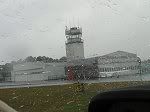 It wasn't going to open any farther, and we really didn't have any other options so we continued the approach. It was good practice. We requested a stop and go from the tower and I made sure the door was closed again before we departed. We did both approaches again with no more distractions. Cardinal doors have been known to come open during rough weather, but the latches are still pretty secure. It would take a good bit of airframe wrenching to pry one open, and I don't think we were in anything that rough. My left knee is just under the handle, and I believe that I must have hit the door handle with it during the turbulence we had. It wouldn't take much to move it enough to disengage the bolt, and a little bit of airframe twisting could easily do the rest. I'll have to keep that in mind...
It wasn't going to open any farther, and we really didn't have any other options so we continued the approach. It was good practice. We requested a stop and go from the tower and I made sure the door was closed again before we departed. We did both approaches again with no more distractions. Cardinal doors have been known to come open during rough weather, but the latches are still pretty secure. It would take a good bit of airframe wrenching to pry one open, and I don't think we were in anything that rough. My left knee is just under the handle, and I believe that I must have hit the door handle with it during the turbulence we had. It wouldn't take much to move it enough to disengage the bolt, and a little bit of airframe twisting could easily do the rest. I'll have to keep that in mind...We were scheduled again for the next day, and although the weather had improved greatly (still IFR but no rain or turbulence) the effects of the previous days drenching were still with us. As soon as I turned on the radios, I saw that the digital display on the #1 radio was only partially lit. Only the upper half of the LED display was visible, so that it was impossible to read the numbers. The #2 radio's display flickered wildly and then went blank. A closer look showed that there was water pooling around the edges of the radio stack. We had seen solid rain all day on Saturday, but Yellowbird's cabin has always been dry in rain, at least on the ground. In any case, there was no noticeable water in the cabin except around the radios.
I pulled the radios from the rack and water dripped out of both units. It took a few blasts of aerosol electronics cleaner and compressed air to get them dried out, but they misbehaved intermittently for a while until they had warmed up and cooked away any remaining moisture. The culprit appears to be the avionics cooling duct, which vents outside air to the radio stack from an intake on the right forward fuselage. There doesn't seem to be any provision to remove water from the cooling air, so for now, any anticipated rain will be warded off with a small scrap of cloth or sponge stuffed in the intake scoop. A more permanent solution, done by some Cardinaleers, would be to cap off the intake altogether and mount an electric cooling fan in the radio stack. I'll think about it...
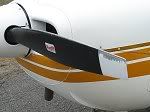 One final side effect of our flight in the rain was the effect on the paint job. Yellowbird still has her original paint, and despite a few touchups, it's in fairly good shape. However, a few hours in the rain were enough to strip most of the paint off the leading edge of the propeller blades, and the paint on the wing leading edges took a beating as well. I've touched up the wings again, but the prop may need professional help. It's coming due for an overhaul, so I may leave it as is until then, but if I fly in the rain much longer, I may not have anything left to overhaul.
One final side effect of our flight in the rain was the effect on the paint job. Yellowbird still has her original paint, and despite a few touchups, it's in fairly good shape. However, a few hours in the rain were enough to strip most of the paint off the leading edge of the propeller blades, and the paint on the wing leading edges took a beating as well. I've touched up the wings again, but the prop may need professional help. It's coming due for an overhaul, so I may leave it as is until then, but if I fly in the rain much longer, I may not have anything left to overhaul.For the math geeks: How fast are the tips of a 78" diameter propeller moving at 2,500 RPM? Does it matter if the airplane that it's attached to is flying though the air at 120 mph? And how hard is a raindrop at that speed? (For extra credit, figure the whole thing out in MPH and knots.)

Many of us go through a lot of instrument training in 'svere clear' conditions. There is nothing like actual IMC to drive all of those lessons home. BTW, one of the real thrills of flying is breaking out at mins to see the airport just where it should be. This just can't be simulated. A very interesting post, thanks!
580.123 mph
I use AOPA's Realtime flight planner to prpeare for my lesson. It provides the map, so all I need do is capture it (I use 2020). For the tracks I use the Garmin program called Mapsource, again capture it for the post. Google Earth Plus allows you to inport GPS tracks.
Now, how do you inbed pictures into the middle of text? I don't seem to be successfuly at getting the text to wrap.
Try this:
<div><a href="[large image]">[Thumbnail image]</a>[text]<br clear="all"></div>
Was doing some surfing for something else and found this site:
http://www.pponk.com/HTML%20PAGES/propcalc.html
Try it, you'll like it.
Dave
"My left knee is just under the handle, and I believe that I must have hit the door handle with it during the turbulence we had."
I've the exact same experience in our Cardinal. It can certainly happen. I'll check, but I think our Cardinal has the avionics cooling vent disabled.
I check, Cardinal N8035G has the avionics cooling inlet blocked off with a metal plate.
We've got a really full panel and no heating problems.
Jim
The tip of your propellor at 78" is travelling roughly (rounded to nearest whole number) 577 mph or 501 knots.
The terminal velocity of a raindrop varies in prportion to its size - at sea level, one about 5 mm across will be falling at 20 mph, while drizzle falls at 4.5 mph. It's really not that relevant compared to the speed the paint on your propellor is going when it smacks into a relatively stationary raindrop. This is why rain and spray pit metal and strip paint, especially on float planes.
For a bonus - the speed of sound is 761 mph at sea level, give or take by conditions. So when you hear a seaplane or guy on wheels who has a prop meant for floats putting in the throttle on the runway and he goes from loud to REALLY LOUD AND THE NEIGHBORS HATE YOU, that's because his prop tips just went transonic / supersonic.